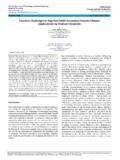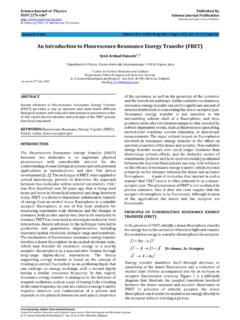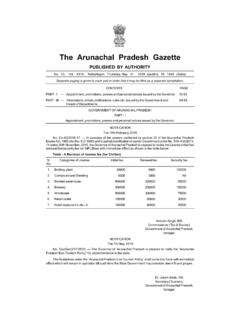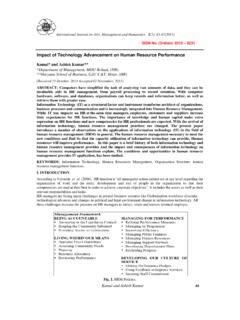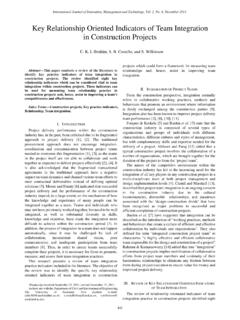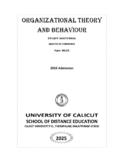Transcription of IMPACT OF GLOBALIZATION - sjpub.org
1 Science Journal ofBusiness ManagementISSN: 2276-6278 Author(s) Attribution ByScience Journal PublicationInternational Open Access Publisher Research ArticleImpact of GLOBALIZATION on Human Resource ManagementOyeyemi KayodeDepartment of Educational ManagementLagos State UniversityCorresponding Author pace of GLOBALIZATION is increasing continuously interms of markets for goods and services, investment and businessopportunities within one or more organizations. This transformationcaused by GLOBALIZATION affects all the department in an organization inwhich human resource management is not left out in this transformationcrusade as it has obligation to move along with the changing demands ofthe GLOBALIZATION process. This paper examines the IMPACT of the workforceon Human Resource Management either locally or internationally also itrevealed the various factors driving GLOBALIZATION in the workforce and theissues and challenges that confront the Human Resource Management inthe global markets, and also the benefits of GLOBALIZATION Human ResourceInformation System (HRIS) to the Human Resource (HR).
2 GLOBALIZATION , Investment, Human Resource Management,Business, and Human Resources Information SystemINTRODUCTIONA ccording to Arthur (1994) see GLOBALIZATION in the tendencyof businesses, technologies or philosophies to spreadthroughout the world, or the process of making this (2004) GLOBALIZATION implies the opinion of local andnationalistic perspectives to a broader outlook of aninterconnected and interdependent world with free transferof capital frontiers. However, it does not include unhinderedmovement of labour and, as suggested by some economists,may hurt smaller or fragile economies if appliedindiscriminately. Greengard (1995) defined GLOBALIZATION asthe system of interaction among the countries of the worldin order to develop the global economy. GLOBALIZATION refersto the integration of economics and societies all over theworld.
3 GLOBALIZATION involves technological, economic,political and cultural exchanges made possible largely byadvances in communication, transportation, andinfrastructure. Armstrong (2004) defined Human ResourceManagement (HRM) as the function within an organizationthat focuses on recruitment of management of, andproviding direction for the people who work in theorganization. Also, Human Resources Management is theorganizational function that deals with issues related topeople such as compensation, hiring, performancemanagement, organization development, safety, wellness,benefits, employee motivation, communication,administration and training. Onasanya (2005) HumanResource Management is also a strategic and comprehensiveapproach to managing people and the workplace cultureand environment .
4 Effective HRM enables employees tocontribute effectively and productively to the overallcompany direction and the accomplishment of theorganization's goals and objectives. Human ResourceManagement is moving away from traditional personnel,administration, and transactional roles, which areincreasingly outsourced. HRM is now expected to add valueto the strategic utilization of employees and that employeeprograms IMPACT the business in measurable ways throughglobalization, therefore Human Resources department aretransforming as the modern business faces numerous andcomplex challenges, and exploit opportunities. Thetransformation of human resources today is a direct call ofthe rapid changes within business due to factors such asglobalization. In the global competition within the flat andconnected new world, decision making in organizations hasbecome increasingly intricate and convoluted.
5 The newglobal world has widened the talent pool for excellent andmarginal workers, and for permanent and fluid organization's talent can be a source for a sustainedcompetitive advantage and can affect importantorganizational outcomes such as survival, profitability,customer satisfaction level, and employee resources need to take advantage of technology anddata analytics to build a global human resource informationsystem that collects and stores data from various system will help to analyze the data to provide businessinsights, predict future needs and develop strategies to fillthose needs. Companies with the ability to foresee andsustainably manage their workforce needs - especially forhigh skills - will gain the decisive competitive advantage(Aina, 2005). The global supply of talent is short of itslong-term demand and the gap is a challenge for employerseverywhere.
6 The shortage between the demand and supplyof talent is likely to continue to increase, notably for highly-skilled workers and for the next generation of multi-nationalorganization. Most organization with large workers NigeriaBreweries Plc may not be able to sustain a net surplusworkforce with the right skills for much longer. Now, morethan ever, organizations need to place greater emphasis onattracting human capital rather than financial capital is broadly available from investors andlenders, and innovations can be duplicated relatively easilyand quickly, effective human resource management is thebest way to differentiate one company from another. Globalstaffing and global leadership development are the twocomponents of global human resources with the greatestpotential for powerful leverage for global firms.
7 Only themultinationals that will be willing to adapt their humanresource practices to the changing global labour marketconditions will be able to attract, develop and retain theright talent, and will likely succeed in the global competition(Griffin, 2002).Volume 2012 (2012), Article ID sjbm-219, Issue 3, 4 Pages, doi: 3rd March, 2012 How to Cite this Article:Oyeyemi Kayode, IMPACT of GLOBALIZATION on Human Resource Management, Science Journal of Business Management, Volume 2012(2012), Article ID sjbm-219, Issue 3, 4 Pages, doi: Driving GlobalizationThe last two decades have seen the evolution of the global manufacturing environment , majority of the manufacturers have global presencethrough exports, strategic alliances, joint ventures or as a part of a committed strategy to sell and produce in foreign markets (Greengard,2005).
8 Page 2 Science Journals Publication(ISSN:2276-6286)(a) Global Market forcesThere is tremendous growth potential in the global markets whichresulted in intensified foreign competition in local markets whichforces the small-and-medium-sized companies to upgrade theiroperations and even consider expanding internationally. There hasalso been growth in demand which necessitates the developmentof a global network of manufacturing bases and markets when themarkets are global, the production - planning task of the managerbecomes difficult on one hand and allows more efficient utilizationof resources on the others.(b) Technological ForcesA peculiar trend which was prevalent in the last decade, besidesglobalization, was a limited number of producers which emergeddue to diversity among products and uniformity across nationalmarkets.
9 Product diversity has increased as products have grownmore complex and differentiated and product life cycles haveshortened. These have been diffusion of technological knowledgeand global low-cost manufacturing locations have emerged. Inresponse to this diffusion of technological capability, multinationalfirms need to improve their ability to tap multiple sources oftechnology located in various countries. They also must be able toabsorb quickly and commercialize effectively, new technologiesthat, in many, cases, were invented outside the firm thusovercoming the destructive and pervasive 'not - invented-hereattitude and resulting inertia.(c) Global Cost ForcesNew competitive priorities in manufacturing industries, that isproduct and process conformance quality, delivery reliability andspeed, customization and responsiveness to customers, haveforced companies to reprioritize the cost factors that drive theirglobal operations strategies.
10 The Total Quality Management (TQM)revolution brought with it a focus on total quality costs, rather thanjust direct labour cost companies realized that early activities suchas product design and worker training substantially impactproduction costs. They began to emphasize prevention rather thaninspection. In addition, they quantified the cost of poor design, lowinput quality and poor workmanship by calculating internal andexternal failure costs. All these realizations placed access to skilledworkers and quality suppliers high on the priority list for firmscompeting on quality. Similarly, Just-in-Time (JIT) manufacturingmethods, which companies widely adopted for the managementof mass production systems, emphasized the importance offrequent deliveries by nearly supplies. A number of high-technology industries have experienced dramatic growth in thecapital intensity of production facilities.
